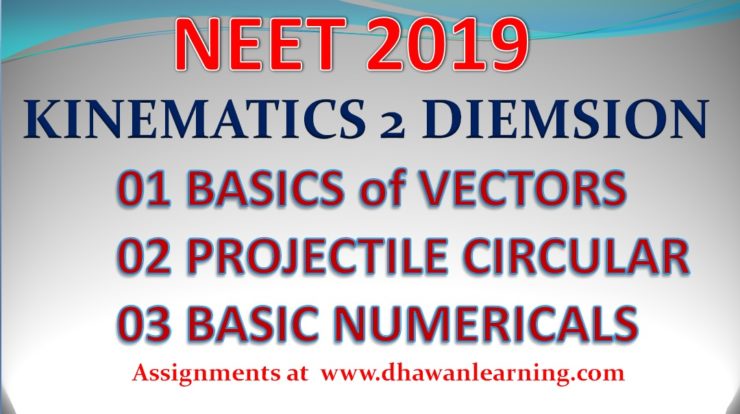
Welcome students !
You are invited to see new videos on the kinematics two dimensional motion.
So now we have three videos back to back you kinematics of two dimensional motion. In the first video we discuss vectors and scalars and also motion in two dimension with basic concepts and thought. We also take care of half projectile motion in this video, after seeing this video you will be able to do Vector calculations of addition subtraction and resolution along with resultant of vectors.

In this video only we use concepts of rain problems and river problems as well. Remember both are having the same concept and you can used rain problems and your problems with same principles. Now after the video in which we have completed half projectile motion, you will be in a position to solve all the questions of half projectile motion, the first video concludes here.
In the second video about the projectile motion we resolve the motion in horizontal and vertical planes. Now you are in a position to resolve horizontal and vertical motion with aim in mind, that horizontal motion will not have any acceleration while vertical motion will have acceleration due to gravity. Hence in the full motion horizontal velocity will not change but vertical motion of the projectile will always and always change. We have we have given the basic formulas for time of flight and horizontal range and height. In the next slide you will come to know the basic discussion of the formulas include that horizontal range remains constant for complementary angles, also for maximum horizontal range we have to take the angle of projectile 45. For maximum height angle of projectile must be 90 degrees. You will see vertical height and time depends on vertical component of the velocity and not at all on the horizontal component of velocity. Range on the other hand depends on both velocities.

After this we come to the last section of kinematics in two dimensions . Here we will take a look at circular motion. Now remember body whenever a body is moving in circular motion, it may or may not change its speed. If it changes its speed, it is called non uniform circular motion on the other hand if the velocity magnitude or speed does not change it is termed as uniform circular motion. In both the cases at least the direction of velocity is changing and hence some acceleration is there, because you know acceleration is defined as the rate of change of velocity. When velocity changes acceleration has to be there. Now we take firstly the case of uniform circular motion in such a case the speed is not changing and only direction is changing. The acceleration that causes body to move in a circular motion is called centripetal acceleration. Always remember that this centripetal acceleration will never change the speed. And the direction of centripetal acceleration is always towards the centre of the circle.

In the second case we will discuss the motion of body, which is changing in direction as well in magnitude so this type of motion is called non uniform circular motion. Remember this type of circular motion will have celebrations one extra acceleration to change then magnitude, but acceleration to change the direction which is called centripetal acceleration will also be there. The another acceleration which changes the magnitude is called tangential acceleration, and it will either increase or decrease the speed. This acceleration is responsible for change in magnitude of velocity. With this we conclude conceptual video two dimensional motion. In the last video we discussed previous years questions damage in motion in various entrance examination.
DOWNLOAD PREVIOUS YEAR
